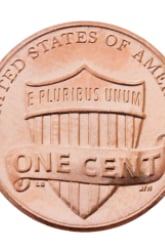Activity
Radioactive Decay
Grade Level: 9th - 12th; Type: Life Science
Objective:
To gain a better understanding of the process of radioactive decay through modeling.
Research Questions:
- What are isotopes?
- What is the half-life of an isotope?
The decay of unstable isotopes is used to determine the age of materials. As unstable isotopes decay they become other elements. Measuring the quantity of each atom in the material can help to determine its age. The half-life is the amount of time it takes for half of the unstable isotope to decay into a different element.
Materials:
- 10 pennies
- Graph paper
- 4 different color pencils
Experimental Procedure:
TRIAL 1
- Place all pennies on your work space heads side up. This represents 10 atoms of the element "HEADranium," a radioactive isotope.
- Pick up all 10 pennies.
- Holding the pennies in one hand 6 inches above the work space, drop the pennies.
- The pennies that landed tails side up represent atoms of a more stable element "magTAILSium."
- Remove the magtailsium atoms from the work space. Count the remaining headranium atoms. Record this value in Table 1under Drop 1.
- Hold only the headranium atoms in your hand. Drop them back on the work space.
- Remove the magtailsium atoms and place with the previously formed magtailsium atoms. Count and record the remaining headranium atoms in the Drop 2 column of Table 1.
- Repeat steps 6 & 7 until all atoms have converted to headranium or until you have completed all 10 drops.
-
TRIAL 2
- Repeat steps 1-8. Record your data in Table 2.
-
TRIAL 3
- Repeat steps 1-8. Record your data in Table 3.
- Calculate the average number of headranium atoms for each drop and record in Table 4.
- Graph your results from Trials 1, 2, 3, and the average in Table 4.
- Place Tosses on the x-axis and the number of headranium on the y-axis.
- Use a different color pencil for each set of data.
- Calculate the average half-life for headranium. This is the number of tosses it took for half of the pennies to "decay" to magtailsium.
- Assume that there are 25 years between drops. Using your Table 4 data, how old would a fossil be with 3 headranium atoms and 7 magtailsium atoms?
-
Table 1
Start Drop 1 Drop 2 Drop 3 Drop 4 Drop 5 Drop 6 Drop 7 Drop 8 Drop 9 Drop 10 Number of headranium atoms 10 Table 2
Start Drop 1 Drop 2 Drop 3 Drop 4 Drop 5 Drop 6 Drop 7 Drop 8 Drop 9 Drop 10 Number of headranium atoms 10 Table 3
Start Drop 1 Drop 2 Drop 3 Drop 4 Drop 5 Drop 6 Drop 7 Drop 8 Drop 9 Drop 10 Number of headranium atoms 10 Table 4
Start Drop 1 Drop 2 Drop 3 Drop 4 Drop 5 Drop 6 Drop 7 Drop 8 Drop 9 Drop 10 Average Number of headranium atoms 10
Terms/Concepts: Isotope; Radioactive decay; Half-life
References:
http://www.colorado.edu/physics/2000/isotopes/radioactive_decay3.html
http://www.videopediaworld.com/video/29266/Atomic-Structure-Radioactivity-And-Dating
Education.com provides the Science Fair Project Ideas for informational purposes only. Education.com does not make any guarantee or representation regarding the Science Fair Project Ideas and is not responsible or liable for any loss or damage, directly or indirectly, caused by your use of such information. By accessing the Science Fair Project Ideas, you waive and renounce any claims against Education.com that arise thereof. In addition, your access to Education.com's website and Science Fair Project Ideas is covered by Education.com's Privacy Policy and site Terms of Use, which include limitations on Education.com's liability.
Warning is hereby given that not all Project Ideas are appropriate for all individuals or in all circumstances. Implementation of any Science Project Idea should be undertaken only in appropriate settings and with appropriate parental or other supervision. Reading and following the safety precautions of all materials used in a project is the sole responsibility of each individual. For further information, consult your state's handbook of Science Safety.















